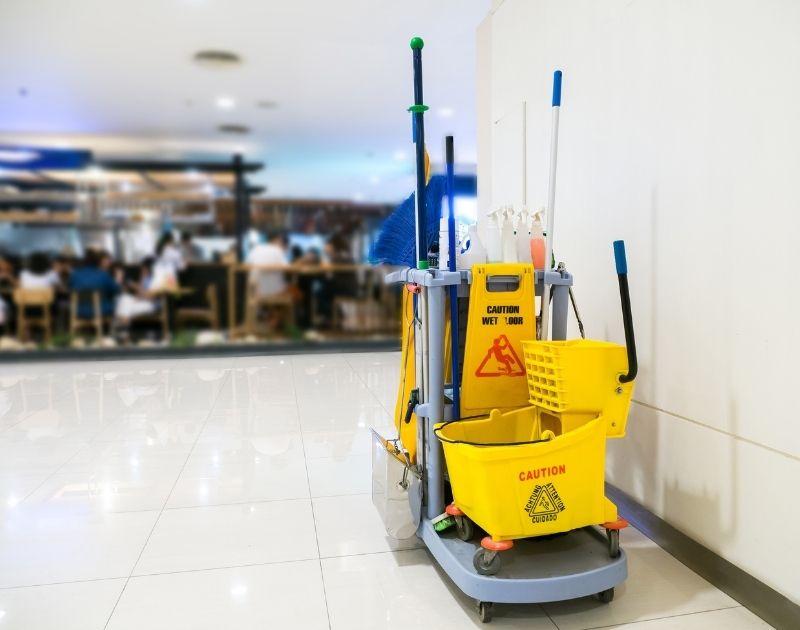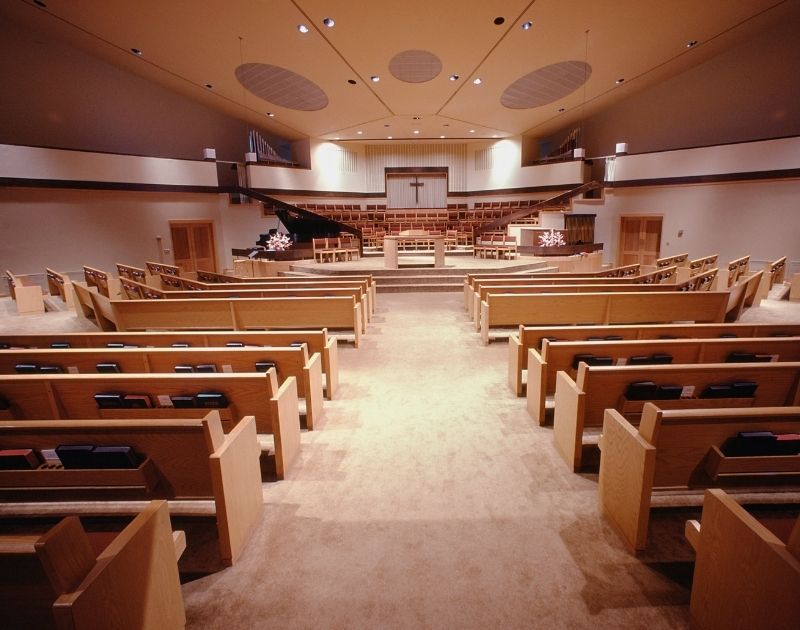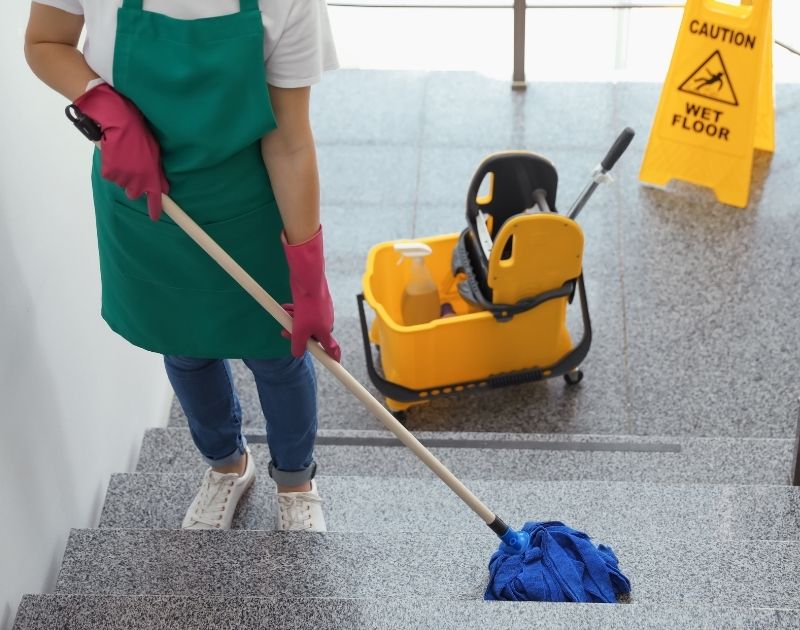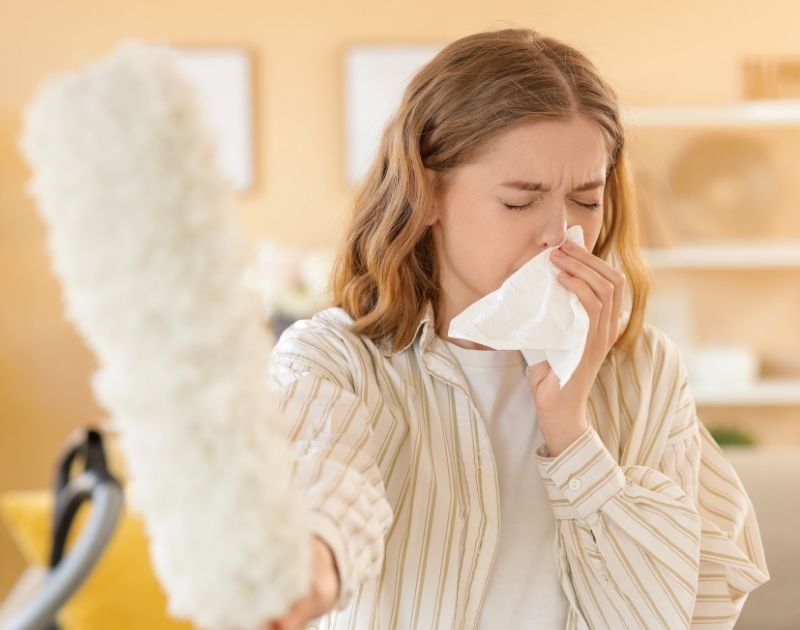In every workplace—from busy offices and schools to warehouses and medical facilities—there’s an invisible threat circulating: germs. Bacteria and viruses thrive on the surfaces employees touch every day, silently spreading illness and lowering productivity. When one sick employee becomes two, and two become ten, the impact quickly snowballs into absenteeism, workflow disruption, and lost revenue.
This is why cleaning schedules aren’t just an operational detail—they’re a strategic defense. A well-structured cleaning routine does more than keep things looking tidy; it helps stop the spread of germs before they affect people and productivity.
At Assett Commercial Services (Assett), we’ve seen firsthand how precise, consistent, and professionally managed Commercial Cleaning Services can transform a workplace’s health and efficiency. Below, we’ll break down the science and strategy behind cleaning schedules that truly reduce germ spread—and how to build one that fits your facility.
Why Cleaning Schedules Matter More Than Ever
The pandemic heightened awareness of cleanliness across industries, but as years pass, many organizations are slipping back into pre-COVID habits. The problem? Germs never stopped spreading.
1. Germs Thrive on High-Touch Surfaces
Research shows that viruses like influenza can live up to 24 hours on stainless steel and plastic. Office desks can harbor more bacteria than a toilet seat. And shared items—door handles, phones, touch screens—become hotspots for transmission.
Without consistent cleaning intervals, these areas become reservoirs of pathogens, undoing the effect of even the most thorough weekly deep clean.
2. Irregular Cleaning Creates “Germ Gaps”
Germs multiply quickly. A surface sanitized on Monday morning can be contaminated again by Tuesday afternoon. Irregular or reactive cleaning schedules (where staff only clean when something “looks dirty”) leave time gaps where pathogens can spread unchecked.
3. Absenteeism Costs Add Up Fast
The U.S. Centers for Disease Control and Prevention (CDC) estimates that productivity losses linked to absenteeism cost employers over $225 billion annually. Many of those lost hours are preventable with consistent disinfection routines.
A professional Janitorial Services partner can reduce this risk through data-driven schedules that focus cleaning where it matters most—helping businesses maintain healthier, more consistent operations.
Core Principles of a Germ-Reducing Cleaning Schedule
A truly effective cleaning schedule isn’t just about frequency—it’s about focus, timing, and accountability. Here’s how high-performing facilities structure their routines.
1. Identify High-Risk Zones
Every workplace has different germ transmission points. For example:
| Workplace Type | High-Risk Areas |
|---|---|
| Offices | Keyboards, phones, desks, breakrooms, conference tables |
| Schools | Desks, door handles, restrooms, water fountains |
| Medical Facilities | Exam tables, waiting rooms, restrooms, touchscreens |
| Warehouses | Equipment handles, time clocks, locker rooms |
| Restaurants | Counters, door handles, prep surfaces, bathrooms |
An Assett Commercial Services site assessment identifies these risk zones during onboarding. From there, a cleaning schedule is tailored to address not just appearance but infection control.
2. Apply the “Three Levels” of Cleaning Frequency
Most workplaces benefit from a layered schedule that includes:
-
Daily Cleaning:
Covers essential touchpoints and visible surfaces. Tasks include wiping door handles, emptying trash, sanitizing restrooms, and cleaning breakrooms. Daily routines ensure no area becomes a bacterial breeding ground between shifts. -
Weekly Cleaning:
Includes deeper disinfection of surfaces and less obvious zones—like air vents, keyboards, and chair backs—that accumulate hidden germs. -
Monthly or Quarterly Cleaning:
Addresses long-term buildup through carpet cleaning, window washing, and HVAC sanitation. These tasks eliminate dust and allergens that contribute to respiratory issues.
Assett’s Commercial Cleaning Services integrate these layers seamlessly, ensuring the schedule reflects how your facility is actually used, not just a generic checklist.
3. Align Cleaning with Usage Patterns
The most effective cleaning doesn’t necessarily happen when the building is empty—it happens when it’s strategic.
For example:
-
Restrooms in high-traffic buildings may need sanitizing mid-day as well as overnight.
-
Breakrooms should be wiped down after lunch periods.
-
Meeting rooms might need disinfecting after each use.
Assett creates time-based cleaning rotations tied to usage peaks—so disinfection happens when it matters most.
4. Use Color-Coded Systems
Cross-contamination is one of the biggest hidden risks in janitorial work. The same cloth used in a restroom should never touch a desk or breakroom table.
Professional janitorial teams use color-coded microfiber systems—one color for restrooms, another for common areas, another for food service zones—to eliminate cross-use and maintain sanitation integrity.
5. Combine Manual and Touchless Methods
Modern cleaning schedules leverage both hands-on and automated technologies:
-
Electrostatic sprayers for broad disinfection coverage
-
HEPA-filtered vacuums to remove allergens and microbes
-
Touchless dispensers and faucets to reduce surface contact
Assett’s equipment lineup includes these advanced systems to maintain consistent cleanliness with minimal interruption to daily operations.
The Science of Surface Survival and Disinfection
To design a cleaning schedule that works, it helps to understand how long germs survive—and what actually kills them.
| Pathogen | How Long It Survives on Surfaces | Effective Disinfectants |
|---|---|---|
| Influenza virus | Up to 24 hours | Quaternary ammonium compounds, bleach |
| Norovirus | Days to weeks | Hydrogen peroxide, bleach |
| SARS-CoV-2 | Hours to days (depending on material) | Alcohol (70%), bleach |
| E. coli | Up to 24 hours | Quaternary ammonium, alcohol |
| MRSA | Up to 7 days | Bleach, hydrogen peroxide |
Regular disinfection interrupts these lifecycles. Missing a single cleaning interval allows these microbes to multiply and spread through touchpoints—elevator buttons, keyboards, phones, and door handles—before the next cleaning cycle occurs.
That’s why a reliable Janitorial Services provider builds redundancy into every schedule. Even if one cleaner misses a shift, another technician is cross-trained to fill in, keeping sanitation continuous and consistent.
How Often Should You Clean Different Areas?
Every facility is unique, but the table below provides a guideline for frequency when the goal is to reduce germ spread:
| Area | Frequency | Recommended Methods |
|---|---|---|
| Door handles & light switches | 2–3x daily | Disinfectant wipes or spray |
| Restroom fixtures | 2–4x daily | EPA-approved disinfectant |
| Desks & keyboards | Daily | Alcohol-based wipes |
| Breakroom tables & appliances | Daily | Sanitizing solution |
| Carpets & floors | 2–3x weekly | Vacuum & disinfecting mop |
| Reception & waiting areas | Daily | Wipe hard surfaces & sanitize chairs |
| Air vents & ducts | Quarterly | Professional cleaning |
| Windows & partitions | Monthly | Streak-free cleaning agents |
Assett Commercial Services tailors these standards based on traffic flow, facility type, and seasonal illness patterns, ensuring cleaning intensity rises during high-risk periods like flu season.
The Role of Employees in a Cleaning Schedule
Even the best professional cleaning plan benefits from employee participation. While Commercial Cleaning Services handle deep and scheduled tasks, daily hygiene awareness helps maintain cleanliness between service intervals.
Encourage Workplace Hygiene Habits
-
Provide disinfectant wipes at desks and shared equipment.
-
Install hand sanitizer stations at entryways and high-traffic zones.
-
Post reminders about handwashing and surface disinfection.
-
Encourage employees to stay home when sick to reduce spread.
Create a “Clean Culture”
Companies that prioritize cleanliness build trust and safety. When employees see restrooms consistently clean, trash emptied, and surfaces sanitized, it communicates that management values their wellbeing. That morale boost translates into loyalty and productivity.
Assett often partners with HR and facilities teams to create internal communication kits—signage, reminders, and reporting systems—to reinforce this culture.
Common Mistakes in Workplace Cleaning Schedules
Many companies maintain a cleaning routine, but few optimize it for germ control. Here are common pitfalls we see during our site evaluations:
1. Overreliance on Visual Cleanliness
A surface can look spotless but still harbor bacteria. For example, glass tables and stainless-steel handles often appear clean while carrying live germs. Visual checks are important, but disinfection protocols should be based on touch frequency, not appearance.
2. Inconsistent Timing
Cleaning too early or too late reduces effectiveness. If restrooms are cleaned after peak hours, contaminants may linger during heavy use periods.
3. Improper Product Usage
Not all disinfectants work for every germ. Some require specific dwell times (contact duration) to kill pathogens. Assett ensures each product is applied correctly and safely according to EPA standards.
4. Cross-Contamination
When cleaning tools aren’t properly segregated between areas, germs can be transferred instead of removed. That’s why professional providers standardize procedures, color-code equipment, and audit compliance.
5. Lack of Accountability
Many in-house cleaning programs fail because no one verifies results. Assett addresses this through performance-based cleaning systems—including digital checklists, QR-coded zones, and supervisor audits—to ensure consistency and transparency.
Adapting Cleaning Schedules for Seasonal Illness and Flu Outbreaks
Germ levels fluctuate seasonally. Fall and winter bring spikes in flu, while spring and summer can increase mold and allergen counts. Adjusting your cleaning frequency during these transitions prevents illness clusters and indoor air quality issues.
Seasonal Adjustments Include:
-
Increasing disinfecting frequency during flu season
-
Deep cleaning HVAC systems before summer
-
Disinfecting high-touch points twice daily during outbreaks
-
Adding fogging or electrostatic disinfection during known exposures
Assett’s flexible scheduling system allows businesses to scale services up or down with minimal disruption. This adaptability is crucial for schools, healthcare facilities, and multi-tenant buildings where population density changes throughout the year.
Why Outsourcing to Professionals Works Best
While some facilities rely on internal staff for cleaning, professional Janitorial Services deliver measurable advantages:
1. Expertise and Training
Professional cleaners are trained in infection control, cross-contamination prevention, and chemical safety—ensuring disinfection is effective and compliant.
2. Accountability
Assett Commercial Services uses digital tracking and inspection tools that verify each area was cleaned on schedule. This data-driven approach gives facility managers confidence that nothing was missed.
3. Cost Efficiency
Outsourcing eliminates payroll taxes, benefits, and management overhead tied to in-house staff. More importantly, professional cleaning reduces sick days and boosts productivity—a direct bottom-line gain.
4. Scalable Coverage
Need mid-day restroom sanitizing, weekend deep cleans, or emergency response? Professional services can scale quickly without adding permanent staff.
5. Compliance and Documentation
Many industries—especially healthcare, manufacturing, and food service—require proof of cleaning for inspections and audits. Assett provides digital logs, service reports, and compliance documentation that simplify record-keeping.
A Sample Cleaning Schedule for a Mid-Size Office
| Time | Task | Responsible Party |
|---|---|---|
| 6:00 AM | Wipe desks, sanitize restrooms, vacuum carpets | Janitorial Team |
| 10:00 AM | Mid-day restroom wipe-down, refill supplies | Day Porter |
| 12:00 PM | Disinfect breakroom tables, appliance handles | Day Porter |
| 3:00 PM | Spot clean glass doors, sanitize meeting rooms | Janitorial Team |
| 6:00 PM | Full restroom clean, mop floors, remove trash | Janitorial Team |
| Weekly | Deep clean carpets, sanitize vents, dust blinds | Janitorial Team |
| Monthly | Floor refinishing, upholstery cleaning | Janitorial Team |
Assett customizes these templates for each client’s footprint, industry, and traffic flow, ensuring a balance between frequency and cost-effectiveness.
How Assett Commercial Services Delivers Cleaner, Healthier Workplaces
At Assett Commercial Services, our approach to Commercial Cleaning Services and Janitorial Services is built on one principle: cleaning should prevent problems, not just react to them.
We combine data-driven scheduling, trained technicians, and advanced disinfection technology to minimize germ spread and create visibly healthier workplaces. Our performance-based systems ensure accountability on every shift—so you never wonder if the job was done right.
Whether your facility is an office, medical practice, school, or industrial space, Assett designs a cleaning schedule that aligns with your operations, reduces illness, and protects your people.
Conclusion: A Clean Schedule Is a Healthy Business Strategy
Germ-reducing cleaning schedules are more than a hygiene routine—they’re a strategic investment in workforce health, client confidence, and operational continuity.
Businesses that clean reactively always fall behind; those that clean proactively stay ahead—preventing illness, protecting reputation, and maintaining productivity year-round.
If your workplace is ready for a smarter, science-based cleaning schedule, partner with the professionals who understand both sanitation and strategy.
Call to Action
Contact Assett Commercial Services today to schedule a consultation and design a custom cleaning schedule that keeps your facility spotless, compliant, and protected from germ spread.
Assett Commercial Services — Commercial Cleaning Services and Janitorial Services you can trust to safeguard your workplace.




